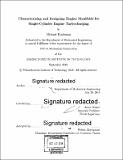Characterizing and designing engine manifolds for single-cylinder engine turbocharging
Author(s)
Buchman, Michael Rafael
DownloadFull printable version (18.20Mb)
Other Contributors
Massachusetts Institute of Technology. Department of Mechanical Engineering.
Advisor
Amos Winter.
Terms of use
Metadata
Show full item recordAbstract
Turbocharging can provide a cost-effective means for increasing the power output and fuel economy of an internal combustion engine. It is commonly used on multi-cylinder engines, but not on commercial single-cylinder engines due to the phase mismatch between the exhaust stroke (when the turbocharger is powered) and the intake stroke (when the engine requires the compressed air). This work explores overcoming the phase mismatch problem by adding an air capacitor: a volume added in series with the intake manifold between the turbocharger compressor and the engine intake. The function of the air capacitor is to buffer the output from the turbocharger compressor and deliver pressurized air during the intake stroke. This research focuses on demonstrating the feasibility of using an air capacitor to enable turbocharging single cylinder internal combustion engines. An analytical model of the system was created from first principles, which showed that the air capacitor turbocharging method could increase power output by up to 40% without heat transfer and up to 70% with heat transfer elements included in the intake manifold (such as an intercooler). An initial, proof-of-concept experiment was created using a generator as a dynamometer. With an air capacitor volume seven times the engine capacity, this setup was able to produce 29% more power compared to the same engine naturally aspirated. A numerical model was developed in Ricardo Wave to predict the performance of turbocharged single cylinder engines with air capacitors under different conditions. An experimental engine with accompanying dynamometer was constructed to demonstrate the effects of manifold sizing on engine performance and to experimentally validate the model. The experiment showed that the model was able to predict power output with an accuracy of 8% of peak power, fuel consumption within 7% error, air mass flow rates with 10% error, and manifold pressures within 7% error. The model was then combined with a simulated annealing optimization scheme in Matlab in order to conceptualize designs for the geometry and timings of single-cylinder turbocharged engines intended for different commercial applications. The optimization showed that adding an air capacitor and turbocharger to a 0.44L engine, with slight modifications to the valve and injector timings, could increase power by 88% compared to natural aspiration. By also modifying the bore and stroke, the turbocharged engine with an air capacitor could reduce fuel consumption by 8% compared to a naturally aspirated engine with equivalent peak power output.
Description
Thesis: Ph. D., Massachusetts Institute of Technology, Department of Mechanical Engineering, 2018. Cataloged from PDF version of thesis. Includes bibliographical references (pages 151-156).
Date issued
2018Department
Massachusetts Institute of Technology. Department of Mechanical EngineeringPublisher
Massachusetts Institute of Technology
Keywords
Mechanical Engineering.